Cristina Campi
Probabilistic approach to longitudinal response prediction: application to radiomics from brain cancer imaging
May 12, 2025Abstract:Longitudinal imaging analysis tracks disease progression and treatment response over time, providing dynamic insights into treatment efficacy and disease evolution. Radiomic features extracted from medical imaging can support the study of disease progression and facilitate longitudinal prediction of clinical outcomes. This study presents a probabilistic model for longitudinal response prediction, integrating baseline features with intermediate follow-ups. The probabilistic nature of the model naturally allows to handle the instrinsic uncertainty of the longitudinal prediction of disease progression. We evaluate the proposed model against state-of-the-art disease progression models in both a synthetic scenario and using a brain cancer dataset. Results demonstrate that the approach is competitive against existing methods while uniquely accounting for uncertainty and controlling the growth of problem dimensionality, eliminating the need for data from intermediate follow-ups.
Segmentation variability and radiomics stability for predicting Triple-Negative Breast Cancer subtype using Magnetic Resonance Imaging
Apr 02, 2025Abstract:Most papers caution against using predictive models for disease stratification based on unselected radiomic features, as these features are affected by contouring variability. Instead, they advocate for the use of the Intraclass Correlation Coefficient (ICC) as a measure of stability for feature selection. However, the direct effect of segmentation variability on the predictive models is rarely studied. This study investigates the impact of segmentation variability on feature stability and predictive performance in radiomics-based prediction of Triple-Negative Breast Cancer (TNBC) subtype using Magnetic Resonance Imaging. A total of 244 images from the Duke dataset were used, with segmentation variability introduced through modifications of manual segmentations. For each mask, explainable radiomic features were selected using the Shapley Additive exPlanations method and used to train logistic regression models. Feature stability across segmentations was assessed via ICC, Pearson's correlation, and reliability scores quantifying the relationship between feature stability and segmentation variability. Results indicate that segmentation accuracy does not significantly impact predictive performance. While incorporating peritumoral information may reduce feature reproducibility, it does not diminish feature predictive capability. Moreover, feature selection in predictive models is not inherently tied to feature stability with respect to segmentation, suggesting that an overreliance on ICC or reliability scores for feature selection might exclude valuable predictive features.
AI-FLARES: Artificial Intelligence for the Analysis of Solar Flares Data
Jan 02, 2024Abstract:AI-FLARES (Artificial Intelligence for the Analysis of Solar Flares Data) is a research project funded by the Agenzia Spaziale Italiana and by the Istituto Nazionale di Astrofisica within the framework of the ``Attivit\`a di Studio per la Comunit\`a Scientifica Nazionale Sole, Sistema Solare ed Esopianeti'' program. The topic addressed by this project was the development and use of computational methods for the analysis of remote sensing space data associated to solar flare emission. This paper overviews the main results obtained by the project, with specific focus on solar flare forecasting, reconstruction of morphologies of the flaring sources, and interpretation of acceleration mechanisms triggered by solar flares.
Three-dimensional numerical schemes for the segmentation of the psoas muscle in X-ray computed tomography images
Dec 10, 2023Abstract:The analysis of the psoas muscle in morphological and functional imaging has proved to be an accurate approach to assess sarcopenia, i.e. a systemic loss of skeletal muscle mass and function that may be correlated to multifactorial etiological aspects. The inclusion of sarcopenia assessment into a radiological workflow would need the implementation of computational pipelines for image processing that guarantee segmentation reliability and a significant degree of automation. The present study utilizes three-dimensional numerical schemes for psoas segmentation in low-dose X-ray computed tomography images. Specifically, here we focused on the level set methodology and compared the performances of two standard approaches, a classical evolution model and a three-dimension geodesic model, with the performances of an original first-order modification of this latter one. The results of this analysis show that these gradient-based schemes guarantee reliability with respect to manual segmentation and that the first-order scheme requires a computational burden that is significantly smaller than the one needed by the second-order approach.
A comprehensive theoretical framework for the optimization of neural networks classification performance with respect to weighted metrics
May 22, 2023Abstract:In many contexts, customized and weighted classification scores are designed in order to evaluate the goodness of the predictions carried out by neural networks. However, there exists a discrepancy between the maximization of such scores and the minimization of the loss function in the training phase. In this paper, we provide a complete theoretical setting that formalizes weighted classification metrics and then allows the construction of losses that drive the model to optimize these metrics of interest. After a detailed theoretical analysis, we show that our framework includes as particular instances well-established approaches such as classical cost-sensitive learning, weighted cross entropy loss functions and value-weighted skill scores.
Operational solar flare forecasting via video-based deep learning
Sep 12, 2022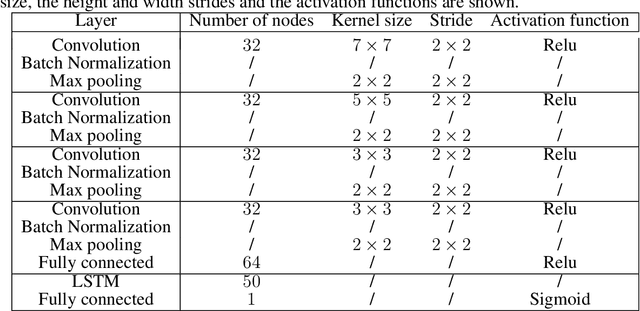

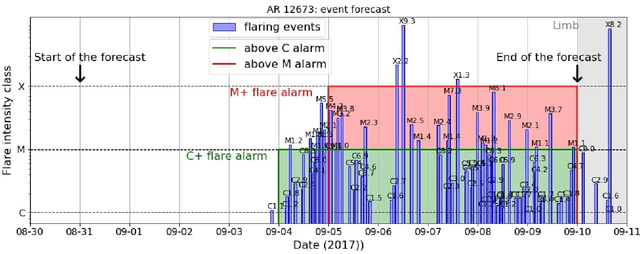

Abstract:Operational flare forecasting aims at providing predictions that can be used to make decisions, typically at a daily scale, about the space weather impacts of flare occurrence. This study shows that video-based deep learning can be used for operational purposes when the training and validation sets used for the network optimization are generated while accounting for the periodicity of the solar cycle. Specifically, the paper describes an algorithm that can be applied to build up sets of active regions that are balanced according to the flare class rates associated to a specific cycle phase. These sets are used to train and validate a Long-term Recurrent Convolutional Network made of a combination of a convolutional neural network and a Long-Short Memory network. The reliability of this approach is assessed in the case of two prediction windows containing the solar storm of March 2015 and September 2017, respectively.
Score-oriented loss (SOL) functions
Mar 29, 2021



Abstract:Loss functions engineering and the assessment of forecasting performances are two crucial and intertwined aspects of supervised machine learning. This paper focuses on binary classification to introduce a class of loss functions that are defined on probabilistic confusion matrices and that allow an automatic and a priori maximization of the skill scores. The performances of these loss functions are validated during the training phase of two experimental forecasting problems, thus showing that the probability distribution function associated with the confusion matrices significantly impacts the outcome of the score maximization process.
Oversampling errors in multimodal medical imaging are due to the Gibbs effect
Mar 10, 2021



Abstract:To analyse multimodal 3-dimensional medical images, interpolation is required for resampling which - unavoidably - introduces an interpolation error. In this work we consider three segmented 3-dimensional images resampled with three different neuroimaging software tools for comparing undersampling and oversampling strategies and to identify where the oversampling error lies. The results indicate that undersampling to the lowest image size is advantageous in terms of mean value per segment errors and that the oversampling error is larger where the gradient is steeper, showing a Gibbs effect.
Machine learning as a flaring storm warning machine: Was a warning machine for the September 2017 solar flaring storm possible?
Jul 05, 2020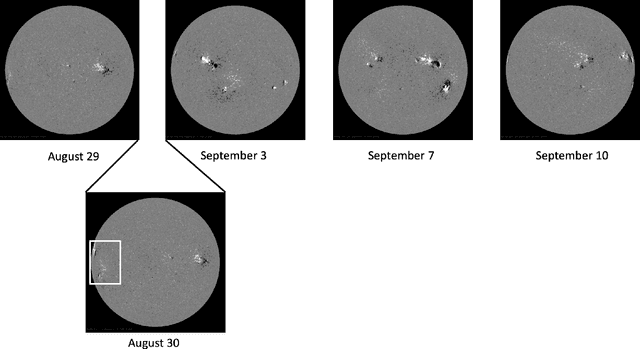
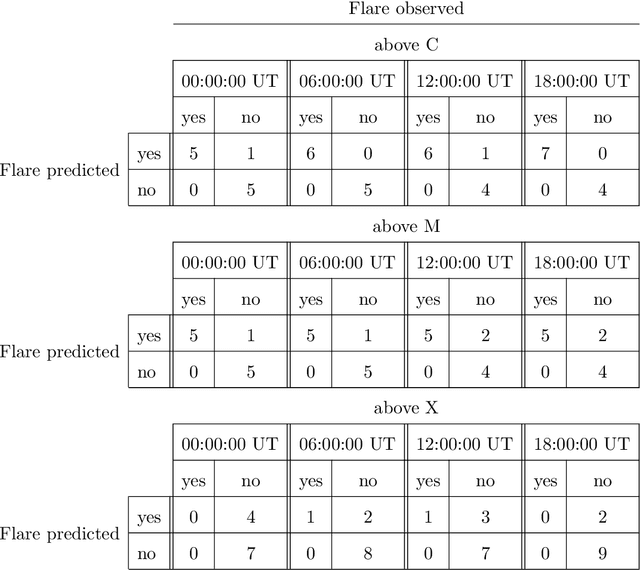
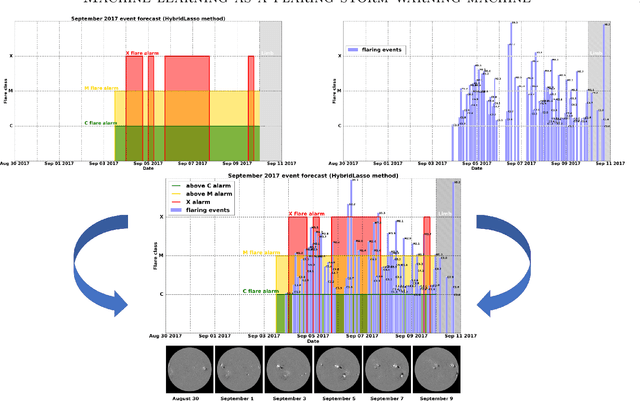
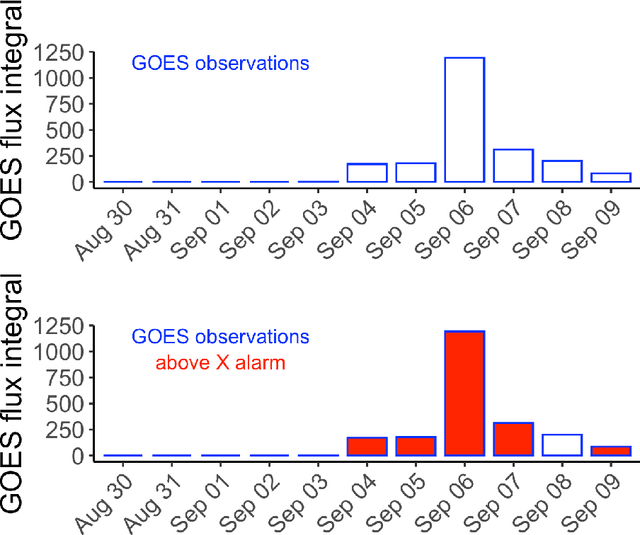
Abstract:Machine learning is nowadays the methodology of choice for flare forecasting and supervised techniques, in both their traditional and deep versions, are becoming the most frequently used ones for prediction in this area of space weather. Yet, machine learning has not been able so far to realize an operating warning system for flaring storms and the scientific literature of the last decade suggests that its performances in the prediction of intense solar flares are not optimal. The main difficulties related to forecasting solar flaring storms are probably two. First, most methods are conceived to provide probabilistic predictions and not to send binary yes/no indications on the consecutive occurrence of flares along an extended time range. Second, flaring storms are typically characterized by the explosion of high energy events, which are seldom recorded in the databases of space missions; as a consequence, supervised methods are trained on very imbalanced historical sets, which makes them particularly ineffective for the forecasting of intense flares. Yet, in this study we show that supervised machine learning could be utilized in a way to send timely warnings about the most violent and most unexpected flaring event of the last decade, and even to predict with some accuracy the energy budget daily released by magnetic reconnection during the whole time course of the storm. Further, we show that the combination of sparsity-enhancing machine learning and feature ranking could allow the identification of the prominent role that energy played as an Active Region property in the forecasting process.
Automated Definition of Skeletal Disease Burden in Metastatic Prostate Carcinoma: a 3D analysis of SPECT/CT images
Jun 19, 2019



Abstract:To meet the current need for skeletal tumor-load estimation in prostate cancer (mCRPC), we developed a novel approach, based on adaptive bone segmentation. In this study, we compared the program output with existing estimates and with the radiological outcome. Seventy-six whole-body 99mTc-DPD-SPECT/CT from mCRPC patients were analyzed. The software identified the whole skeletal volume (SVol) and classified it voxels metastases (MVol) or normal bone (BVol). SVol was compared with the estimation of a commercial software. MVol was compared with manual assessment and with PSA-level. Counts/voxel were extracted from MVol and BVol. After six cycles of 223RaCl2-therapy every patient was re-evaluated as progressing (PD), stabilized (SD) or responsive (PR). SVol correlated with the one of the commercial software (R=0,99, p<0,001). MVol correlated with manually-counted lesions (R=0,61, p<0,001) and PSA (R=0,46, p<0.01). PD had a lower counts/voxel in MVol than PR/SD (715 \pm 190 Vs. 975 \pm 215 and 1058 \pm 255, p<0,05 and p<0,01) and in BVol (PD 275 \pm 60, PR 515 \pm 188 and SD 528 \pm 162 counts/voxel, p<0,001). Segmentation-based tumor load correlated with radiological/laboratory indices. Uptake was linked with the clinical outcome, suggesting that metastases in PD patients have a lower affinity for bone-seeking radionuclides and might benefit less from bone-targeted radioisotope therapies.
 Add to Chrome
Add to Chrome Add to Firefox
Add to Firefox Add to Edge
Add to Edge